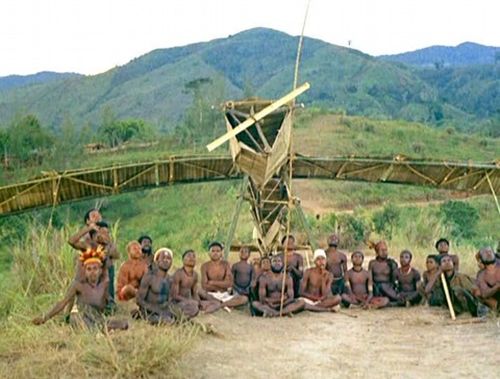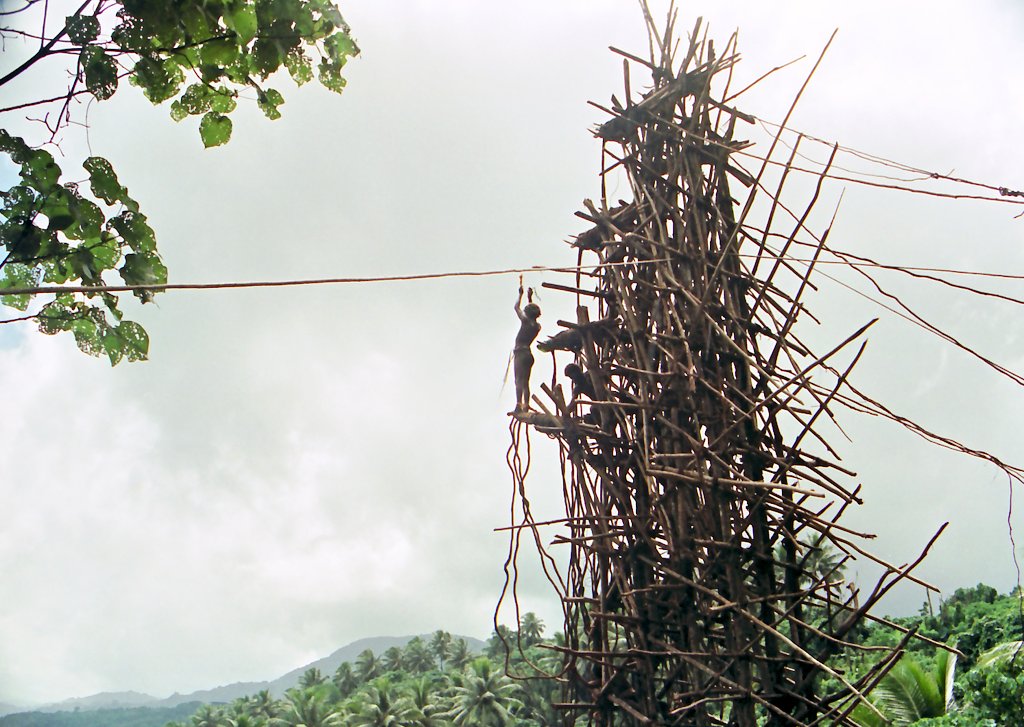<= 79. Burundi 81. Seychelles =>
1. Vanuatu Flag
In 1980 France and Britain agreed that New Hebrides (Vanuatu) would be granted independence on 30 July. About two months before that date Jimmy Stevens, head of the Na-Griamel movement, started a 12-week long uprising as he tried to establish the "State of Vermerana" on the Vanuatuan island of Espiritu Santo.
Papua New Guinean troops arrived to help and they defeated easily Stevens' followers who only had bows, arrows, rocks and slings as weapons. Jimmy Stevens surrendered finally when his son was killed in August.
At the trial it was found out that Na-Griamel was supported by the Phoenix Foundation, an American business foundation that hoped Na-Griamel to establish a tax haven in New Hebrides. Also the French government was found out to have supported Stevens secretly.
That was the reason why French troops took no action as the rebellion started and even refused allowing Britain to deploy troops to help the Vanuatuan government.
The foreign press gave the name Coconut War to the crisis as the Papua New Guinean soldiers arrived to suppress the rebellion.
3. World's highest density of languages
About 112 languages are spoken in Vanuatu, which makes Vanuatu the country with the world's highest density of languages per capita. An average of 2000 people one language when you divide the total amount of the population with the amount of languages spoken.
Vanuatu has three official languages, which are English, French and Bislama. Bislama is a creole language evolved from English.
4. Land Diving
On the island of Pentecost there's a tradition called the land diving, which is a precursor to bungee jump. Men jump from even 20 or 30 meters with tree vines wrapped around their ankles without any safety equipment. It's believed that a good dive ensures a good yam harvest.
5. Vanuatu Cults
There are two good examples of cargo cults in Vanuatu. These emerged generally when European people confronted Polynesian people.
Prince Philip movement
A religious sect of the Kastom people in Vanuatu, believe that Prince Philip, the husband of Queen Elizabeth II, is a divine being. The belief came about in the 1950s and 1960s and it was strengthened in 1974 when the royal couple visited Vanuatu.
The reason for this belief is that there is a legend telling about a son of a mountain spirit who travelled over the seas to a distant land and married there a powerful lady and in time he would return to Vanuatu. Prince Philip was seen as a match to these characteristics and so he became a target of worship.
John Frum
The religion centered on John Frum arose in the 1930s in the island of Tanna in Vanuatu. John Frum is depicted as an American WW II serviceman and people believe that he will bring wealth and prosperity to the people who follow him.
John Frum cult is still strong and besides being a religious institution it's also a political party with a member in the Parliament.
Timeline
1. Vanuatu Flag
Vanuatu consist of 80 islands and the Y shape in the flag comes from the fact that these 80 islands form a Y shape on the map.
Red = represents blood which is the same color in every human being
Green = represents the islands and their lush nature
Black = represents mold and the dark Melanesians
Yellow Y = represents the beam of Bible
Wild boar fang = traditional symbol for prosperity and wellbeing
Leaves of Cycad plant = token of peace and their 39 leaflets represent the 39 members of the Parliament of Vanuatu
2. Coconut WarRed = represents blood which is the same color in every human being
Green = represents the islands and their lush nature
Black = represents mold and the dark Melanesians
Yellow Y = represents the beam of Bible
Wild boar fang = traditional symbol for prosperity and wellbeing
Leaves of Cycad plant = token of peace and their 39 leaflets represent the 39 members of the Parliament of Vanuatu
 |
| Map of Vanuatu |
In 1980 France and Britain agreed that New Hebrides (Vanuatu) would be granted independence on 30 July. About two months before that date Jimmy Stevens, head of the Na-Griamel movement, started a 12-week long uprising as he tried to establish the "State of Vermerana" on the Vanuatuan island of Espiritu Santo.
Papua New Guinean troops arrived to help and they defeated easily Stevens' followers who only had bows, arrows, rocks and slings as weapons. Jimmy Stevens surrendered finally when his son was killed in August.
At the trial it was found out that Na-Griamel was supported by the Phoenix Foundation, an American business foundation that hoped Na-Griamel to establish a tax haven in New Hebrides. Also the French government was found out to have supported Stevens secretly.
That was the reason why French troops took no action as the rebellion started and even refused allowing Britain to deploy troops to help the Vanuatuan government.
The foreign press gave the name Coconut War to the crisis as the Papua New Guinean soldiers arrived to suppress the rebellion.
 |
| Jimmy Stevens |
About 112 languages are spoken in Vanuatu, which makes Vanuatu the country with the world's highest density of languages per capita. An average of 2000 people one language when you divide the total amount of the population with the amount of languages spoken.
Vanuatu has three official languages, which are English, French and Bislama. Bislama is a creole language evolved from English.
 |
| People of Pentecost island |
4. Land Diving
On the island of Pentecost there's a tradition called the land diving, which is a precursor to bungee jump. Men jump from even 20 or 30 meters with tree vines wrapped around their ankles without any safety equipment. It's believed that a good dive ensures a good yam harvest.
5. Vanuatu Cults
There are two good examples of cargo cults in Vanuatu. These emerged generally when European people confronted Polynesian people.
Prince Philip movement
A religious sect of the Kastom people in Vanuatu, believe that Prince Philip, the husband of Queen Elizabeth II, is a divine being. The belief came about in the 1950s and 1960s and it was strengthened in 1974 when the royal couple visited Vanuatu.
The reason for this belief is that there is a legend telling about a son of a mountain spirit who travelled over the seas to a distant land and married there a powerful lady and in time he would return to Vanuatu. Prince Philip was seen as a match to these characteristics and so he became a target of worship.
 |
| Prince Philip believers |
The religion centered on John Frum arose in the 1930s in the island of Tanna in Vanuatu. John Frum is depicted as an American WW II serviceman and people believe that he will bring wealth and prosperity to the people who follow him.
John Frum cult is still strong and besides being a religious institution it's also a political party with a member in the Parliament.
 |
| John Frum followers with a grass airplane
Vanuatu Pictures
|
Timeline
4000 years ago Vanuatu was inhabited by Melanesian people
1606 The Portuguese navigator Fernando de Queirós led a Spanish expedition to Vanuatu being the first Europeans at the area
1768 Louis Antoine de Bougainville is the first European for a long time since the Spanish short-lived settlement in the 1600s
1774 The British captain James Cook mapped the region giving it the name New Hebrides according to the Hebrides of Scotland
1800s British and French merchants and missionaries move to the area. The migrants start producing cotton, coffee, cocoa and copra on their plantations
1887 The British and French both regard New Hebrides as their own property, the dispute is solved by creating a common commission for the administration of the islands
1906 Double-governance, Britain rules the British migrants and France the French migrants, native Melanesians were ruled by the common governance without the nationality of neither of the two countries. The islands had two official languages, two police forces, three judiciary systems, three currencies and two flags
1940s During the World War II the Melanesian population started requiring for their rights as the Americans arrived at the islands
1980 France and Britain accept the independence of New Hebrides under the name of Vanuatu
1980 Jimmy Stevens and his Na-Griamel party declare Vemarana independent, the rebellion was suppressed and the Papua New Guinean troops came to help
Sources:
https://en.wikipedia.org/wiki/Vanuatu
http://www.ethnologue.com/statistics/country
https://en.wikipedia.org/wiki/Prince_Philip_Movement
https://en.wikipedia.org/wiki/Cargo_cult
"Maailman maat liput ja historia" by Kimmo Kiljunen
https://en.wikipedia.org/wiki/Land_diving
http://www.ethnologue.com/statistics/country
https://en.wikipedia.org/wiki/Prince_Philip_Movement
https://en.wikipedia.org/wiki/Cargo_cult
"Maailman maat liput ja historia" by Kimmo Kiljunen
https://en.wikipedia.org/wiki/Land_diving






No comments:
Post a Comment